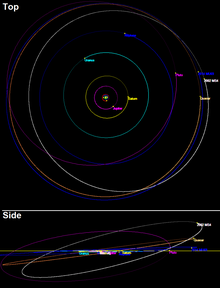(307261) 2002 MS4
 2002 MS4有着比创神星更斜但相似的轨道,此图显示其于2018年1月1日的位置。 | |
| 发现[1] | |
|---|---|
| 发现者 | 查德·特鲁希略 迈克尔·E·布朗 |
| 发现日期 | 2002年6月18日 |
| 编号 | |
| MPC编号 | 2002 MS4 |
| 其它名称 | none |
| 小行星分类 | QB1天体 (MPC)[2] 离散盘天体 (DES)[3] |
| 轨道参数[4] | |
| 历元 June 18, 2009 (2455000.5) | |
| 远日点 | 47.858 AU (7159.4 Gigameters) |
| 近日点 | 36.004 AU (5386.12174 Gigameters) |
| 半长轴 | 41.931 AU (6272.78832 Gigameters) |
| 离心率 | 0.14135 |
| 轨道周期 | 271.53 yr |
| 平均轨道速度 | 4.58 km/s |
| 平近点角 | 210.108° |
| 轨道倾角 | 17.693° |
| 升交点黄经 | 216.086° |
| 近日点参数 | 213.200° |
| 物理特征 | |
| 大小 | 934 ± 47 km[5]
726 ± 123 km[6] |
| 反照率 | 0.051+.036 −.022[5] 0.084+.03 −.02[6] |
| 温度 | ≈43 K,-230.15℃ |
| 光谱类型 | B-V=0.69; V-R=0.38[7] |
| 视星等 | 20.6[8] |
| 绝对星等(H) | 3.8[4] |
小行星307261,临时编号为 2002 MS4,是太阳系中目前最大的未命名天体,前任(225088) 2007 OR10已于2020年获得名称“共工”。于2002年6月18日由查德·特鲁希略和迈克尔·布朗发现。
迈克尔·布朗认为其很可能是矮行星[9]。斯皮策空间望远镜观察估计它的直径为726±123 公里[6]。Herschel团队亦估计它为934±47 公里,这使它成为目前已知10个最大的海王星外天体之一[5],且其有足够大的体积而可被视为IAU 2006年草案提案中的矮行星[10]。目前其距离太阳47.2天文单位,并将在2123年到达近日点[4]。
目前它已被观察55次,最早的回溯发现可以回溯至1954年4月8日[4]。
参考文献[编辑]
- ^ MPEC 2002-W27 : 2002 MS4, 2002 QX47, 2002 VR128. IAU Minor Planet Center. 2002-11-21 [2009-08-26]. (原始内容存档于2012-07-14).
- ^ MPEC 2009-P26 :Distant Minor Planets (2009 AUG. 17.0 TT). IAU Minor Planet Center. 2009-08-07 [2009-08-31]. (原始内容存档于2010-04-10).
- ^ Marc W. Buie. Orbit Fit and Astrometric record for 02MS4. SwRI (Space Science Department). 2008-05-03 using 46 of 46 observations [2009-08-31]. (原始内容存档于2011-06-04).
- ^ 4.0 4.1 4.2 4.3 JPL Small-Body Database Browser: (2002 MS4). 2008-05-03 last obs [2009-08-24]. (原始内容存档于2012-04-15).
- ^ 5.0 5.1 5.2 Vilenius, E., Kiss, C., Mommert, M.; et al. "TNOs are Cool": A survey of the trans-Neptunian region VI. Herschel/PACS observations and thermal modeling of 19 classical Kuiper belt objects (PDF). 2012-04-04 [2012-05-07]. (原始内容存档 (PDF)于2018-12-04).
- ^ 6.0 6.1 6.2 Stansberry, Grundy, Brown, Spencer, Trilling, Cruikshank, Luc Margot Physical Properties of Kuiper Belt and Centaur Objects: Constraints from Spitzer Space Telescope (2007) Preprint arXiv (页面存档备份,存于互联网档案馆)
- ^ Tegler, Stephen C. Kuiper Belt Object Magnitudes and Surface Colors. 2006-01-26 [2006-11-05]. (原始内容存档于2006年9月1日).
- ^ AstDyS 2002MS4 Ephemerides. Department of Mathematics, University of Pisa, Italy. [2009-08-27]. (原始内容存档于2009-09-04).
- ^ Michael E. Brown. How many dwarf planets are there in the outer solar system? (updates daily). California Institute of Technology. [2011-08-25]. (原始内容存档于2011-10-18).
- ^ Gingerich, Owen. The Path to Defining Planets (PDF). Harvard-Smithsonian Center for Astrophysics and IAU EC Planet Definition Committee chair: 4. 2006-08-16 [2007-03-13]. (原始内容存档 (PDF)于2020-10-25).
| ||||||||||||||||||||||||||||||||||||||||||||||||||||||
| ||||||||||||||||||||||||||||||||||||||||||
